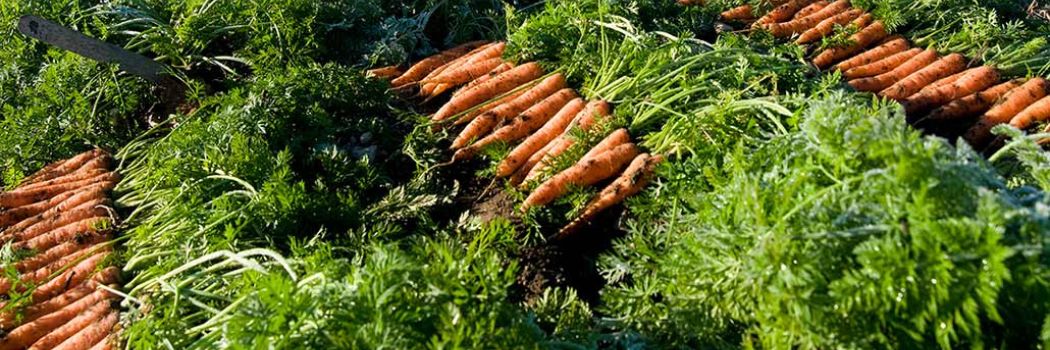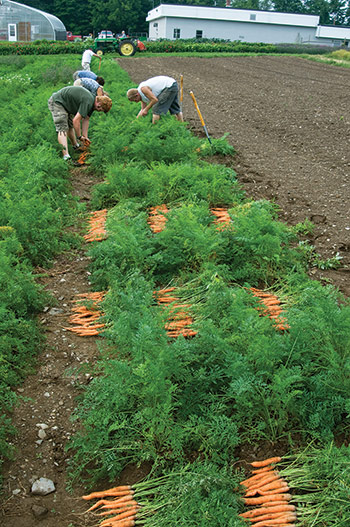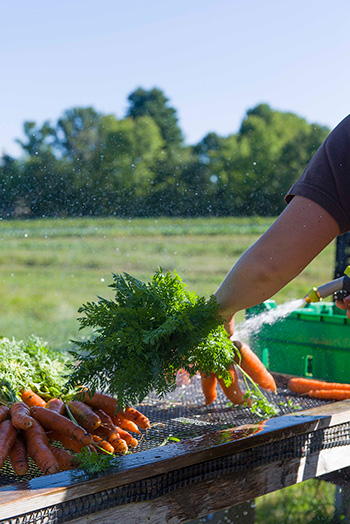- Carrot Growing Guide | Fundamentals of Bed Preparation, Spacing, Weeding & Watering - Part 1
- Carrot Growing Guide | Season Extension to Lengthen Your Carrot Harvest - Part 2
- Carrot Growing Guide | Carrot Harvesting, Handling & Storage - Part 3
- Carrot Growing Guide | Common Carrot Pests & Diseases - Part 4
- Colored Carrot Varieties | Visual Comparison Chart (PDF)
- Carrots | Key Growing Information
- Early, Main Crop & Storage Carrot Varieties | Photo Comparison Chart (PDF)
- Pelleted Carrots | Key Growing Information
- Video: How to Grow Carrots • From Seed to Harvest
- Video: 'Glow Stix Sunrise Mix' Carrots | Exclusively from Johnny's Selected Seeds
- Classic Storage Crops | Post-Harvest Handling & Storage Guidelines
- Winter Growing Guide | Part 6: Recommended Crops & Varieties
- Choosing Carrots: A Guide to Varieties You Will Dig
- Webinar Slide Deck | Choosing Carrots: A Guide to Varieties You Will Dig | PDF
- Choosing Carrots: A Guide to Varieties You Will Dig
- Webinar Slide Deck | Flower Seed Starting Fundamentals | PDF
Carrot Harvesting, Handling & Storage
When to Harvest • How to Store • Recommendations for Best Eating Quality & Shelf Life
Carrot Growing Guide
- Fundamentals of Carrot Culture
- Carrot Season Extension
- Carrot Harvest, Post-Harvest Handling & Storage
- Common Carrot Pests & Diseases
We often hear from growers asking us how to tell when carrots are ready for harvest and the best way to store carrots. Here are some general guidelines and practices to follow for the best eating quality and shelf life.
1 • Dr. Navazio on When to Harvest Carrots
Carrots intended for storage should be harvested when the carrot tips are full and the flavor is well-developed. Fall storage carrots are harvested after a few light frosts but before a hard frost, while they can still be easily dug.
A hard frost will damage any portion of the plants above the soil surface. Light frosts can occur when temperatures reach 34°F (-1.1°C), according to the National Weather Service (NOAA), and a hard freeze is possible when temperatures fall below 28°F (-2.2°C). For planning purposes use your average first fall frost date as a cut-off date, but keep an eye on the forecast to pinpoint your actual best date.
Just as with early and main crop carrots, days to maturity (DTM) can vary under different growing conditions. As the planned harvest date approaches, pull a few samples from your carrot bed and to see if the carrot tips are full and whether flavor is as fully developed as possible.
Johnny's Plant Breeder, Dr. John Navazio, has pulled a many a carrot. "Don't judge a carrot by its seed packet's days-to-harvest number," Dr. Navazio advises in a podcast with gardening maven Margaret Roach. "Catalogs and labels may say 65 to 70 days for many varieties," but "that is not my experience." Depending upon conditions and type, "they can take 95 to 100ish, even."
Add a tickler to your calendar on the date suggested by the variety's DTM number, but remember that with all things edible, sensory input rules the day. According to Dr. Navazio, the most sensible way to tell is to simply "pull a few to see if you've got 'tip fill' yet—at least some degree of blunting at the end," then "taste for full development of flavor." He adds, "You can eat them sooner, of course, but why waste a mouthful?"
2 • Best Carrot Varieties For Storage
Many carrot varieties can be stored, but some store better than others. Carrot varieties bred for storage retain their flavor and excellent eating quality even during long-term storage.We recommend 'Bolero' as an excellent storage carrot variety; not only is it a reliable performer year after year, but it demonstrates excellent eating quality both fresh and after long-term storage. For an adaptable and flavorful storage variety available in organic seed, we recommend 'Bengala'.
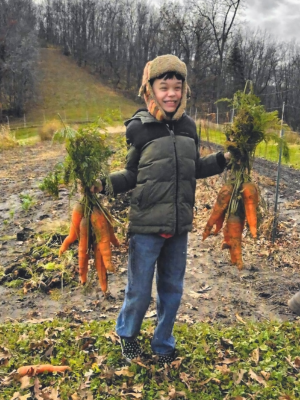
Johnny's customer Mike Hall and his grandson Waylon were so thrilled with their 'Bolero' harvest that they sent us this picture!
3 • Harvesting & Preparing Carrots for Storage
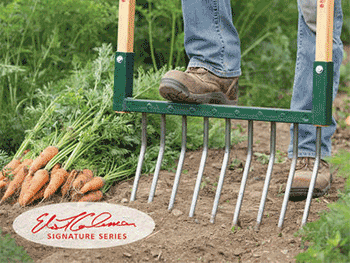
Eliot Coleman designed the 920 Harvest Broadfork to benefit both harvester and harvest: the 9 curved tines spaced across the 20" breadth of the fork allow for quick, gentle loosening of the soil while lifting the roots to the surface, sparing damage to both your carrots and your backbone.
- Harvest on a cool day in fall, to avoid over-warming the roots in the sun.
- To harvest, gently pull, or use a garden fork or our Harvest Broadfork to lift the roots from the ground.
- Once roots for storage are harvested, the tops should be removed. Cut the tops off, about ¼–½" above the root shoulders, and shake or rub off excess soil.
- Do not invite decay by cutting the root ends or removing the root hairs.
Once the tops are removed, the carrots can either be stored with any remaining soil still clinging to them, or washed and allowed to briefly air dry before storing. Much has been written to cover the various methods of handling carrots and how to store them. Some suggest washing roots before storage, some suggest not washing the roots. (For pros and cons of washing carrots, see below.) Other articles discuss methods, such as storing roots in bins of damp sand, sawdust, or leaves, while others indicate a damp storage medium isn't necessary. Read on for a few storage options.
4 • How to Store Carrots—Temperature & Humidity Recommendations
Basics of Storing Carrots
- Temperatures in the range of 32–38°F (0–3°C) are ideal, with a relative humidity of 98%.
- Carrots can be stored for several months, provided a) the stored roots are mature and in good shape (with minimal damage); and b) proper temperature and humidity are maintained.
- Use smallest roots first.
- Check every couple of weeks for signs of decay and cull any roots that have degraded.
For the commercial grower
One of the more common methods of storing carrots for commercial growers is to store them in large bins or crates that are lined with plastic sheets. The crates should be lined so that air circulation can take place: air should be able to enter from the base of the crate, then exit in a passive fashion through the top. This method helps maintain the ideal humidity of 98% while ensuring proper ventilation to reduce risk of mold and rot.
For the smaller-scale grower & home gardener
To store carrots in the fridge, simply lay roots of similar length in a single layer inside gallon freezer bags. Remove the air from the bags and seal, then stack flat on a shelf or in the crisper drawer.
To create a simple, small-scale storage system, loosely place the roots in food-grade, 5-gallon buckets. Drill a few holes, roughly ⅜" or so in diameter, through the bottom, sides, and lid of the bucket to allow for proper ventilation while maintaining the proper humidity levels.
Sandboxes or buckets for storage
Another option is to use clean, sharp, moist sand in 5-gallon plastic buckets, in wax-lined cardboard boxes, or in plain cardboard boxes lined with plastic garbage bags. Fill the bottom of the bucket or box a few inches deep with moistened sand and position the carrots in the sand, with no contact between the individual carrots. Add sand and carrots in layers as space permits until the bucket or box is nearly full, then top with moist sand. The buckets and boxes will be heavy, so it's easiest to position them where they will remain in storage them before filling them.
Can carrots be left in the ground in winter?
This depends upon where you grow, the size of your yield, harvesting resources, and space for storing it.
- If ground temperatures stay moderate (well above freezing), you'll want to harvest your carrots as soon as they're ready and place them under the cooler storage conditions noted above, to prevent crop loss.
- In cooler growing zones, the crop can remain in place with minimal or no protection until the ground freezes, provided there is good soil drainage.
- Where winters are severe, the crop must be protected. Before the first hard frost, cover the bed with a 12–18" layer of straw mulch or leaves, or layer Agribon+ AG-19 blankets over hoops then cover with plastic, either in the field or within a high tunnel, to prevent the ground and the carrots from freezing hard and ruining your crop. As the weeks progress, simply sweep the mulch aside or lift the blankets and harvest as needed. If you get much snow and ice, you will additionally need to provide for access to continue harvesting your protected bed as needed.
5 • Considerations: To Wash or Not to Wash
Most commercial growers wash their carrots before storage, but roots can be stored either washed or unwashed. Each has its advantages and drawbacks. We encourage you to keep records of your storage methods and conditions, as your findings may be different from year to year and between varieties.
Washing before storage
Pros
- When it's time to remove carrots from storage for winter markets, they will have already been cleaned, so they will require no extra time to prepare.
- Washing reduces the possibility of root staining.
- If your wash station is unheated, washing will be much more pleasant in the fall than in the depths of winter.
Cons
- Extra handling of roots prior to storage can cause damage, which can lead to other problems during long-term storage.
- Cleaning takes up time and attention at a time of year when other crops need your time and attention.
- Before they can go into storage, washed carrots must be allowed to air-dry.
Washing after storage
Pros
- Handling doesn't take place until a few days or so before market. This reduces the timespan between possible damage and consumption, thereby minimizing extent of damage.
- Other crops are not being neglected in the field while the carrots are being washed.
- Roots do not require air-drying time, since they are not washed/wet before storage.
- Leaving the carrots unwashed while in storage allows beneficial bacteria to remain intact on the root surface, where they compete with detrimental bacteria.
Cons
- Roots must then be washed in the middle of the winter. (This is not a problem if your washing station has supplemental heating.)
- Roots may become stained by the soil while kept in storage.
Handle with Care
Carrot harvesting, post-harvest handling, and storage practices vary widely at the regional, grower, and carrot variety levels. Provided you take care to minimize damage while harvesting, preparing for storage, and during storage, and the stored carrots remain within the bounds of optimal temperature and humidity requirements, there is some flexibility to the specifics of these practices. So keep these tips in mind as you go about determining what works best for you.
Further Reading
- Next up in our carrot-growing series:
- Common Carrot Pests & Diseases • Article
- Fundamentals of Carrot Culture: Bed Prep, Spacing, Weeding & Watering • Article
- More resources:
- Classic Storage Crops: Post Harvest Handling & Storage Guidelines • Article
- How to Grow Carrots, with Dr. John Navazio • A Way to Garden
- Hygienic & Sanitary Design for Produce Farms • University of Vermont Extension Ag Engineering
- Cleaning Produce Washing Equipment: Root Barrel Washer Checklist • Cornell Cooperative Extension Vegetable Program (PDF)


